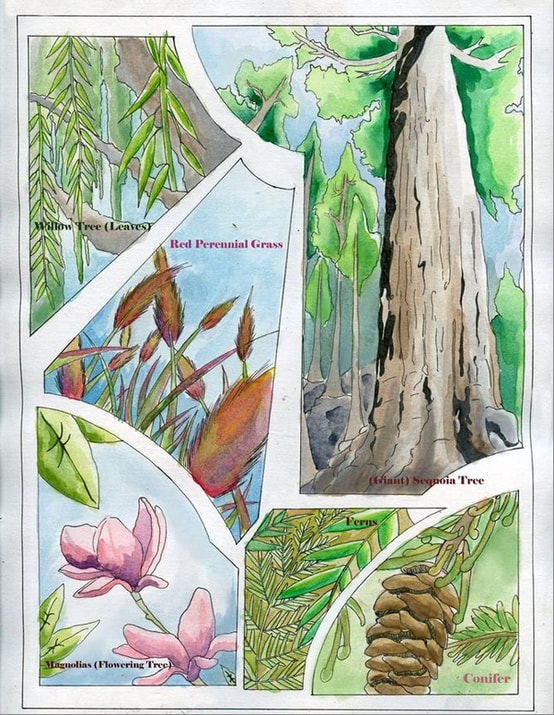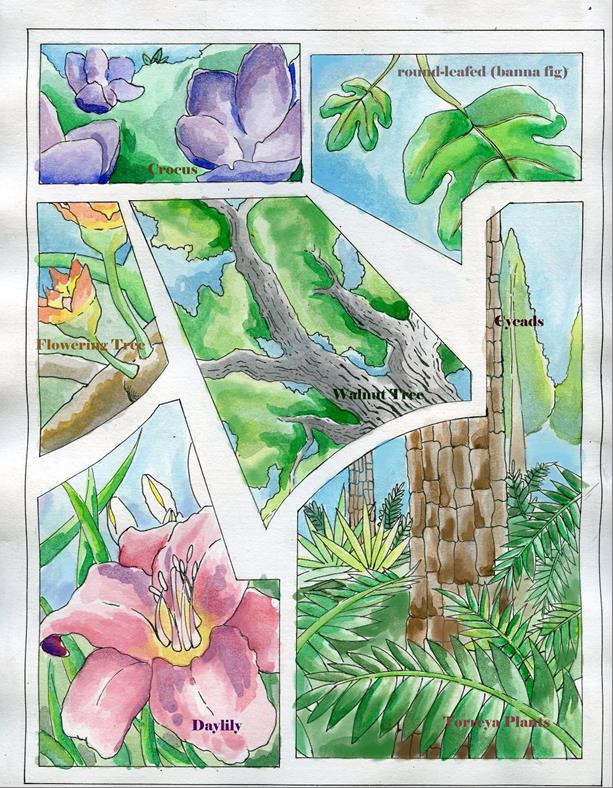22A; Veatch & Stephenson 1911
Cretaceous Material
By Thomas Thurman

Broken Arrow Bend
Broken Arrow Bend is a small eastern point of Chattahoochee River about 1 mile south of where Upatoi Creek merges with the Chattahoochee. Veatch and Stephenson report that an exposure a couple of hundred yards long can be seen at the base of a bluff about 140 to 150 feet high. A fossil bearing bed is the second up from the base and is described as coarse, crossbedded sand and laminated clay containing pieces of petrified wood, large logs and small pieces of lignite (brown coal wood). Fossil leaves were found in a black lens of clay about 8 inches thick several feet above the water level. E. W. Berry identified the following plants from this location.
This is Edward W. Berry who was born in New Jersey in 1875 and started his career as an amateur scientist; he originally described and named many of these species.
Cretaceous plants reported from this bed:
Scientific Name Common Name
Malapoenna horrellensis Laurel family
Phragmites pratti Reed, perennial grass
Salix eutawensis Willow family
Salix flexuose Willow family
Sequoia reichenbachi Sequoia, Cypress family, related to giant sequoia
Chimney Bluffs, Chattahoochee River
About 4.5 miles southwest of Cusseta, GA
This is Fort Benning property where Chattahoochee River makes it’s farthest eastern point in Chattahoochee County. The bluffs are eastward from the river point. The base bed of some bluffs about 5 feet high and shows dark, brown, coal-like, clay rich sand with black lenses of mica rich clay; lignite; as brown coal wood, is present in all forms from fragments to logs. Poorly preserved fossil leaves are abundant in some clay lenses.
E. W. Berry identified the following plants from this location.
Scientific Name Common Name
Araucaria bladenensis Evergreen conifer
Ficus crassipes Round-leafed banana fig
Ficus krausiana Fig tree
Salix flexuosa Willow family
Salix lesquereuxii Willow family
Sequoia reichenbachi Sequoia, Cypress family, related to giant sequoia
Victory Drive Bridge
In Fort Benning, just southeast of Columbus where Victory Drive (Highway 27) crosses Upatoi Creek, Veatch and Stephenson report a wealth of fossil in the bluffs beneath the bridge. Reported vertebrate finds are three distinct species of Cretaceous sharks.
Upatoi Creek
Within Fort Benning, at the Muscogee/Chattahoochee County line is a location known as McBride Ford, 11 air-miles south of east Columbus, where a bluff stands on the south bank of the river.
Cretaceous material underlies about 6 feet of unconsolidated sands as an irregularly crossbedded sand/sandstone with chocolate to black clay lenses, angular quartz pebbles, feldspar fragments, with recognizable wood fragments as coal (lignite) in some cases as logs. Some of the clay lenses contain leaf fragments. One such lens, 6 to 10 inches thick, produced a number of well-preserved Cretaceous leaves which were collected for identification.
Reported Cretaceous plant fossils:
Scientific Name Common name
Andromeda cretacea Heath family, Flowering plant
Andromeda wardiana Heath Family, Flowering plant
Androvettia elegans Conifer
Aralia eutawensis Flowering shrub or tree
Brachyphyllum macrocarpum Conifer
Cinnamomum heeri Cinnamon tree, Laurel family
Cinnamomum newberryi Cinnamon tree, Laurel family
Eucalyptus angusta Eucalyptus, Myrtle family
Ficus ovatifolia Fig tree or shrub
Manihotoides georgiana Manihot, spurge, related to Cassava
Juglans arctica Walnut family
Magnolia boulayana Magnolia; common Southeastern flowering tree
Magnolia capellinii Magnolia; common Southeastern flowering tree
Menispermites variabilis Related to curare plant; Family; Menispermaceae
Paliurus upatoiensis Species of flowering shrub or small tree
Salix flexuosa Willow family
Sequoia reichenbachi Cypress family, related to giant sequoia
Tumion carolinianum Genus; Torreya; related to Nutmeg Yew
Zizyphus laurifolious Related to Buckthorn
Chattahoochee River Bluffs at Blufftown, GA
This town is extinct but was mapped by Veatch and Stephenson at about 4.5 miles northeast of Omaha at a sharp eastward bend in the river in Stewart County approximately 31.25 air miles south of Columbus. From the bluffs they reported a wealth of Cretaceous invertebrates, shark’s teeth, fish vertebra and crab claws.
Omaha Railroad Bridge
One eighth mile below the railroad bridge east of Omaha Cretaceous invertebrates and shark fossils were collected at a level 5 to 8 feet above the water.
Florence/Omaha, GA; (As Florence Marina on some maps)
Stewart County; where Georgia Highway 39C (running east-west) runs into Georgia Highway 39 (running north-south). There is (was?) a bluff about 45 feet high with Cretaceous invertebrates, shark and crocodilian teeth occurring at the lower five feet of the middle strata, which is about 20 feet thick. These sediments are a grey, to green, clay rich marine sands.
Buena Vista/Tazewell Road
Reported as along the Buena Vista/Tazewell Road (State Highway 137, Dr. Deryl Hart Road); there is a hill from Tazewell back towards Buena Vista with the hill cresting where power lines cross the road (modern description). The lower 50 feet of this hill, on the Tazewell side, is composed of coarse, light colored, crossbedded, feldspar rich sand locally with iron concretions; with white to black clay lenses. The clay lenses are local in character giving place over a short distance to sand. The black clay lenses are sparsely leaf bearing and have a thickness of 4 to 5 feet.
Reported Cretaceous plants
Scientific Name Common Name
Andromeda novae-caesareae Heath family
Araucaria bladenensis Conifer; evergreen
Doryanthophyllum cretaceum No Information Found, likely reassigned.
Eucalyptus angusta Eucalyptus
Ficus (Species?) Fig
Manihotoides (Species?) Manihot, spurge, related to Cassava
Monocotyledon (Species) Monocot; family including daylilies & wheat
Byron, Georgia
At a point about 1.5 miles northeast of Byron in a railroad cut through an 18 foot high hill. The hill is crowned by a 5 to 8 foot layer of light gray to yellow, stratified, sand and clay of Cretaceous (?) age. Below this is a 10 foot layer of drab, layered, and laminated clay. On the southwest end of the lower layer there is a six foot section of dark drab to chocolate colored clay containing Cretaceous plant fragments, these were collected and submitted to E. W. Berry
Cretaceous plants reported
Scientific Name Common Name
Araucaria jefferyi Conifer
Cunninghamites elegans Conifer
Dryopteris Fern
In 2012 Jay Batcha (Friend & Editor for the Mid-Georgia Gem and Mineral Society) and I tried to locate this Byron, Georgia location but the railroad cuts proved too overgrown. We located the hill crown but could not confirm fossil bearing sediments in a lower bed.
Clay County, Georgia at Pataula Creek, “The Narrows”
Two miles above junction with Chattahoochee River and nine miles north of Fort Gaines fossils from three species of Cretaceous sharks were collected.
Renfroe’s Station
Stewart County, reported in several railroad cuts 1 to 1.25 miles north of Renfroe’s Station, which no longer exists. The City of Renfroe stands on the Chattahoochee/Stewart County line and here the railway (or former railway) diverts northeast from following Highway 280 and heads across county through hilly terrain. Fossils are reported as both vertebrate shark fossils & invertebrate material loose in soils of the rail road cut, having weathered out.
Ideal, Georgia
Reported in 1911 as a railroad cut 1 1/8 miles north of town, this may not be accurate or the original rail line may no longer exist. Current railroad is about 0.5 mile north of downtown in a series of side roads and bridges built around a low promontory where the railroad parallels Whitewater Creek. Three species of Cretaceous sharks, a mosasaur tooth and fragments of bone were recovered.
Artist Xavier Sims created these watercolors of Cretaceous plants to show a different Georgia than today; a tropical environment.
